CLASSICAL ASSOCIATION OF IRELAND Editorial

Gréigis agus Gaeilge
The CAI has long sponsored the Latin Reading Group and more recently the Ancient Greek Reading Circle, encouraging members to (re)turn to the Classical languages through reading and translating passages from the great authors.
A new initiative is about to get underway: ancient Greek as Gaeilge! Not a few of us who come together for the pleasure of reading Greek texts in the original are Irish speakers. And the thought arose: why not approach the literature as Irish speakers? Why not translate ó Ghréigis go Gaeilge? From Greek to Irish?
Look out for further information very soon on two dates over the summer when you’ll be invited to try your Greek and your Gaeilge!
Dear fellow CAI Members,
Welcome to the summer edition of your newsletter! Inside you will find a roundup of our many and varied recent activities, as well as an invitation to the CAI Summer School – our first since the Covid hiatus! We look forward to seeing you all in Maynooth on 18-19 August!
The image above of the ruined Temple of Amphiaraos, the healing god, comes to you fresh from the district of Oropos, about 40km north of Athens, courtesy of our friend (and convenor of the Greek and Latin Reading Groups) Liam Bairéad. May your own summer plans be as adventurous!
Selga Medenieks
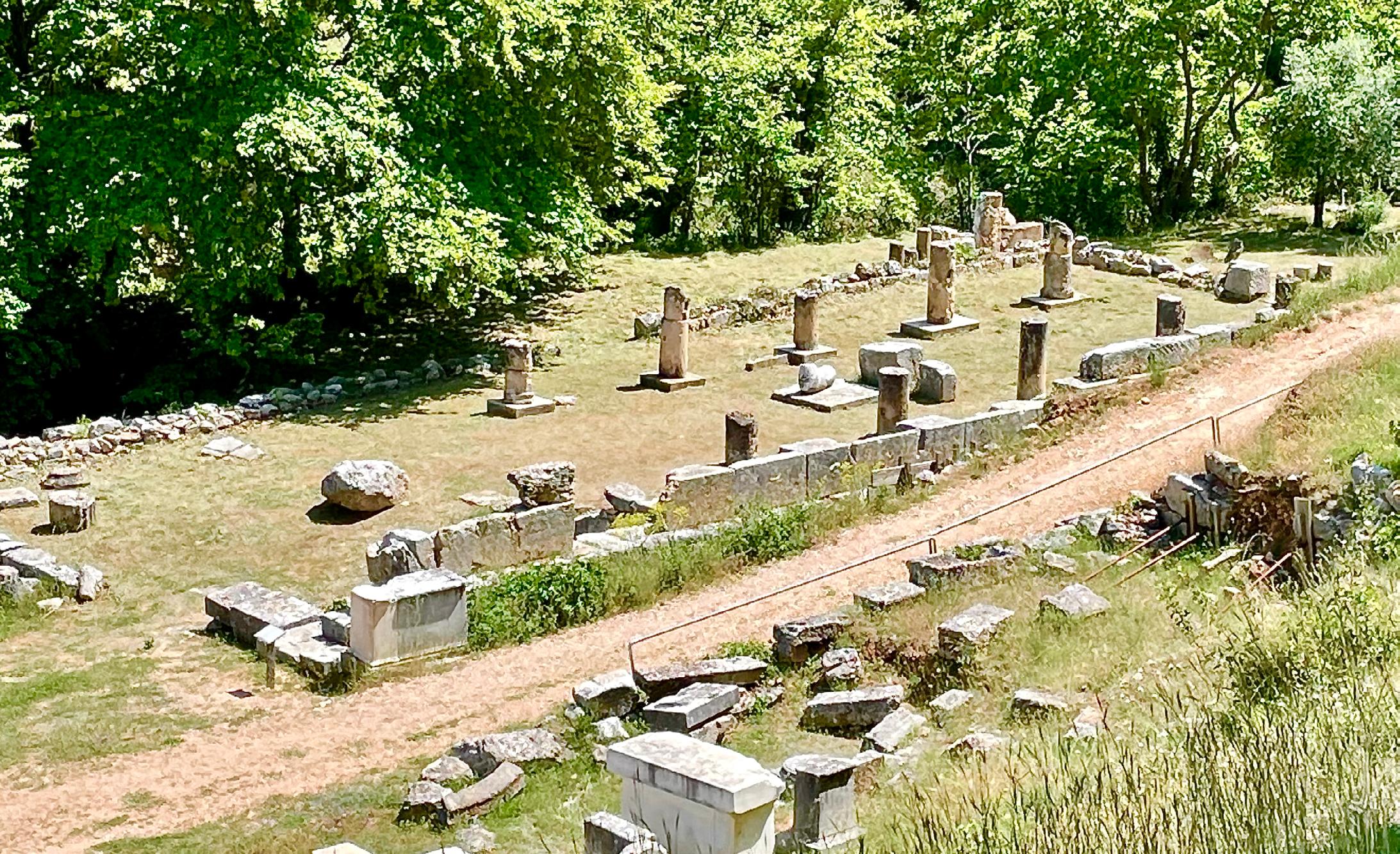
JUNE 2023
2-3 NEWSLETTER
CAI PRESIDENTIAL ADDRESS 2023 MARKING THE LIFE OF J. D. BOURCHIER 4-5 BRANCH AND UNIVERSITY NEWS 10+
Photo (c) Liam Bairéad
Classical Association of Ireland
PRESIDENTIAL ADDRESS 2023
By HELEN McVEIGH
The CAI Presidential address took place in University College Dublin on 2 March 2023.

Since 2020, for obvious reasons, the CAI has been unable to hold this annual event and awards presentation, so it was an emotional experience for many current members and new friends to be together in the beautiful new auditorium in UCD Village.
The event was opened by Helen McVeigh, Chair of the CAI Central Council, who gave a short review of the year and thanked the office holders of the Council for their dedication and commitment to the CAI.
This was followed by an engaging and intriguing lecture by the Honorary President of the CAI, Professor Fran O’Rourke, Emeritus Professor of Philosophy at University College Dublin.
2 JUNE 2023
The audience was taken on a compelling journey through the compositions of a number of Irish poets who have been influenced by Greek philosophy, and we were even entertained by a song from Professor O’Rourke himself. I have no doubt that the lecture inspired many of us to pick up our poetry anthologies as soon as we returned home.
A vote of thanks was proposed by Paddy Sammon, current President of the Irish-Hellenic Society.
The Irish secondary school students who achieved the highest marks in Classical subjects in 2022 examinations were announced. The Centennial Medal for highest overall marks in the Leaving Certificate was shared between Liam O Laoide and Rohan Devereux of Gonzaga College (teacher: Lucy Corcoran), both for ancient Greek, and awarded in absentia.
The President's Medals for highest marks in individual subjects were presented to Luke Nicholas of Glenstal Abbey, for Latin (teacher: Father Christopher Dillon), pictured above, and Aoife Haines (in absentia) of St Andrew's College, for Classical Studies (teacher: Edmund Flanagan).
At the time, the name of the Jack Henderson Medal awardee for the highest overall mark in a Junior Certificate Classics subject had not yet been released. The medal will be presented at a later date.

In his closing remarks, Dr Alexander Thein, CAI Treasurer, invited the audience to visit the new CAI website and gave an overview of the variety of events offered. Do visit https://classical-association-ie.carrd.co
The evening concluded with very welcome refreshments served in the lobby area outside the auditorium. On behalf of the CAI, sincere thanks to the Irish-Hellenic Society for their generous support.

3 www.classicalassociation.ie CLASSICAL ASSOCIATION OF IRELAND
Above : CAI Hon. President Fran O'Rourke with Medal awardee Luke Nicholas and his teacher Fr Christopher Dillon.
Below : CAI Chair Helen McVeigh congratulates Luke Nicholas.
Photos (c) Selga Medenieks
Bruff, Co. Limerick: MARKING THE LIFE OF J.D. BOURCHIER
By PATRICK J. RYAN and PAULA KEANE
CAI Limerick Branch was represented on 22 March 2023 at the unveiling of a plaque in the town of Bruff, the ancestral home of a noted Classical scholar who is featured in a publication of the Irish Institute of Hellenic Studies at Athens (IIHSA). The Lure of Greece (2007) records Irish involvement in Greek culture, literature, history, and politics. One contribution to that publication is entitled “An ardent lover of Cretan freedom”, by Christine Morris (TCD), and records the life of James David Bourchier (1850–1920). The title comes from a eulogy delivered by the then Prime Minister of Greece, Ελευθέριος Βενιζέλος (Eleftherios Venizelos, 1864-1936), himself a Cretan, who names Bourchier as a personal friend and goes on to say that “his friendship with Crete lasted until the end of his life”. It is recorded that when Venizelos made his first speech as Prime Minister in Athens, Bourchier was with him on the platform. He was also a friend of King Giorgos I of Greece (who was assassinated 1913).
In the century after his death, however, Bourchier was almost unknown in Ireland, even in his native place of Bruff. Indeed, the only local mention of him is in an auctioneers’ advertisement when his former home, Baggotstown House, came on the market in 2003. The property, to quote the ad, “is a little gem with some very attractive features. It’s only been in the hands of two families since it was built and has been well-loved and maintained over the years”. Originally, the estate would have had about 1,000 acres, said the auctioneer, Michael Liston, who, along with Ger Mitchell, was selling this six-bedroomed mansion for the guide price of €800,000. “Now with a dwindled demesne, but enough land in 56 acres for a decent, horsey lifestyle, this is a gem waiting to be polished.” Baggotstown, built in 1745, had fallen into some disrepair but has since been restored and is now the property of the Purtill family.
Local interest revived again when, as the centenary of Bourchier’s death approached in 2020, his life was researched and published by local historian Martin O’Brien. Martin gave an online talk on the subject to CAI Limerick Branch during the Covid lockdown.
The idea for a commemorative plaque was initiated when the Ambassador of Bulgaria to Ireland, Her Excellency Gergana Karadjova, visited Limerick in January 2022. Limerick City and County Council granted approval for the project and Bruff Post Office was chosen as the location. The plaque was designed by the Bulgarian Embassy, in consultation with specialist Petko Mangachev and with Martin O’Brien, and has an inscription in English and Bulgarian Cyrillic. The image chosen of James Bourchier is the same one appearing in
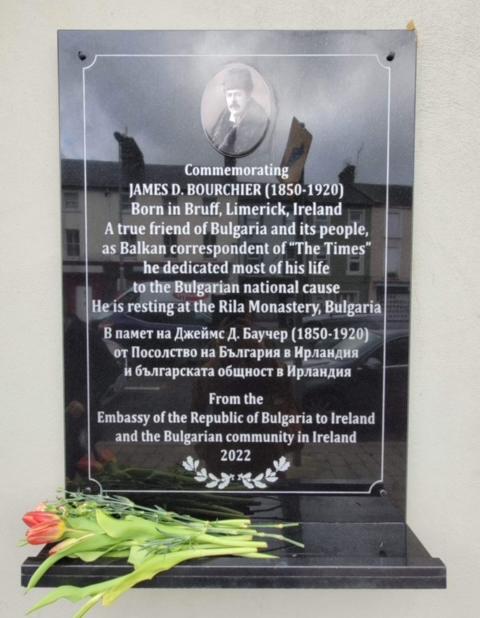
The day of the unveiling was a festive occasion for the Bulgarian Embassy and the local community in Bruff. The former ambassadors of Ireland to Bulgaria Geoffrey Keating and Michael Forbes were in attendance. The Bulgarian community in Ireland was represented by the principals of the Bulgarian schools in Dublin and Shannon, as well as lecturers in Bulgarian language and literature at Trinity College Dublin.
James was the son of John Bourchier, a county magistrate and successful horse-breeder; Baggotstown in his time produced the outstanding steeplechaser Salamander, which won the 1866 Aintree Grand National under jockey Alec Goodman. The Bourchiers were of Huguenot origin, though the French name was more usually written and pronounced in Limerick as “Boucher”. James entered TCD in 1870, became a Classical Scholar and graduated in 1873 with a gold medal for Classics. He then won a scholarship to King’s College, Cambridge, where he was placed in the first grade of the Classical Tripos in 1876. He became an assistant master at Eton College, but it appears that he found teaching to be the wrong profession for him and was quite unsuited to the Etonian way of life. Part of the reason may be that he began during this time to suffer from deafness, which became progressively worse throughout his life. He therefore turned to journalism and soon became Balkan correspondent of The Times of London. For the
4 JUNE 2023
Christine Morris’ article. The oak branches on the lower part of the plaque are a popular symbol in Bulgarian national heraldry.
remainder of his life, he travelled incessantly in Greece, Bulgaria, Macedonia, Montenegro, and Romania, became an expert on Balkan politics and history, and achieved the highest honours available, particularly from Bulgaria (the Order of St Alexander). When asked how he managed such a distinguished career despite his deafness, he said that condition was a considerable advantage in the world of diplomacy! He was also noted as an excellent conversationalist, linguist, and musician. A fellow of the Royal Geographical Society, he spent much time exploring the Balkans’ Hellenic past. He wrote on archaeology and travel, as well as politics, contributing frequently to various reviews, and wrote several articles on the Balkans for the Encyclopaedia Britannica (11th edn).
Upon his death in Sofia, Bulgaria, on 30 December 1920 he was accorded a state funeral celebrated by the Archbishop of Sofia and attended by a representative of the King, and had the high honour of burial at Rila monastery, the only foreigner buried there. The Bulgarian government issued three series of postage stamps with his name and image, the last for his centenary in 2020. Streets are named for him in Sofia, Plovdiv, Varna, Sliven, and Blagoevgrad. Sofia’s new metro system opened in 2012, its main station named for Bourchier. Near the Rila monastery two natural features are named Bourchier Peak and Bourchier Valley, and on Smith Island in Antarctica is located Bourchier Cove.
The authors (below) represented the Classical Association at the commemoration in Bruff; Limerick County and City Council was represented by Deputy Mayor Kieran O’Hanlon; Superintendent Paul Reidy and Inspector Gary Thompson represented An Garda Síochána. Following the unveiling and speeches, the attendees were invited into the Post Office for a reception hosted by the Ambassador, where a wide selection of Bulgarian refreshments was served in honour of Bruff’s noted journalist, diplomat and classicist.


5 www.classicalassociation.ie CLASSICAL ASSOCIATION OF IRELAND
Below : The Bulgarian Ambassador to Ireland, Her Excellency Gergana Karadjova, with the Deputy Mayor of Limerick, Cllr Kieran O’Hanlon. Behind them: Martin O’Brien, historian, with Supt Paul Reidy and Insp. Gary Thompson, An Garda Síochána.
UCD Access Classics
By BRIDGET MARTIN Director, UCD Access Classics
Access Classics, the second-level outreach programme run by the UCD School of Classics, enjoyed another busy and activity-filled academic year! Working with the UCD Classics Museum, we welcomed second-level school groups from Dublin, Wexford, and Leitrim to the UCD campus, where the students enjoyed a range of activities, such as tours of the Museum collection, artefact handling, unlocking the mysteries of ancient languages, and creating curse tablets! We also continued our visits to schools: a particular highlight was meeting the newly formed Classics Club in St Raphaela’s Secondary School in Stillorgan (above). It was great to see such enthusiasm for Classics in a school that does not currently offer the subject at Junior or Senior Cycle! We were also delighted to continue the strong tradition of collaboration beyond the UCD Classics corridor, joining forces with the UCD College of Arts and Humanities to welcome visiting students from America during the summer; with UCD Global to introduce newly arrived international students to options available for study in university; and with UCD Access and Lifelong Learning to bring Classics to DEIS-school students during a UCD Experience day in March.
Our most large-scale collaboration this year was with the Classical Association of Ireland – Teachers on two events: the Young Classicist Awards and the Leaving Certificate lecture day. Access Classics’ Dr Christopher Farrell and Dr
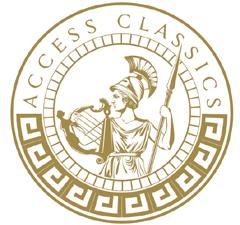
Bridget Martin enjoyed reprising their role as two of the judges for the Awards and, on 14 March, were delighted to facilitate CAIT in hosting the Awards in UCD (in person for the first time since 2020!). On the day, the finalists in the four categories – Junior Award (1st-3rd year), Senior Award (4th-6th year), Languages Award (for a project based on/with a component of Latin or Ancient Greek), and the Sustainability Award (for a project connected to Global Sustainability Goals) – presented their projects to the 400+ crowd of students and teachers. The students did amazing work, producing creative projects ranging from stop-motion animation videos to hand-drawn comic strips, paintings, sculptures, posters, essays, PowerPoints, and even some spoken ancient Greek! It was very heartening to see the inventiveness of the students, and in particular to see some winning entries from students who have not yet formally begun learning Classics. To round out the day, Access Classics’ Dr Bridget Martin gave a short lecture on Greek tragic drama as a preface to an amazing studentproduction of Euripides’ Medea (right) ! Close on the heels of the Awards, we organised and hosted the in-person return of the CAIT Leaving Certificate Lecture day on 25 March. The UCD School of Classics lecturers kindly gave up their Saturday afternoon to present short lectures on aspects of the new Leaving Certificate curriculum (the
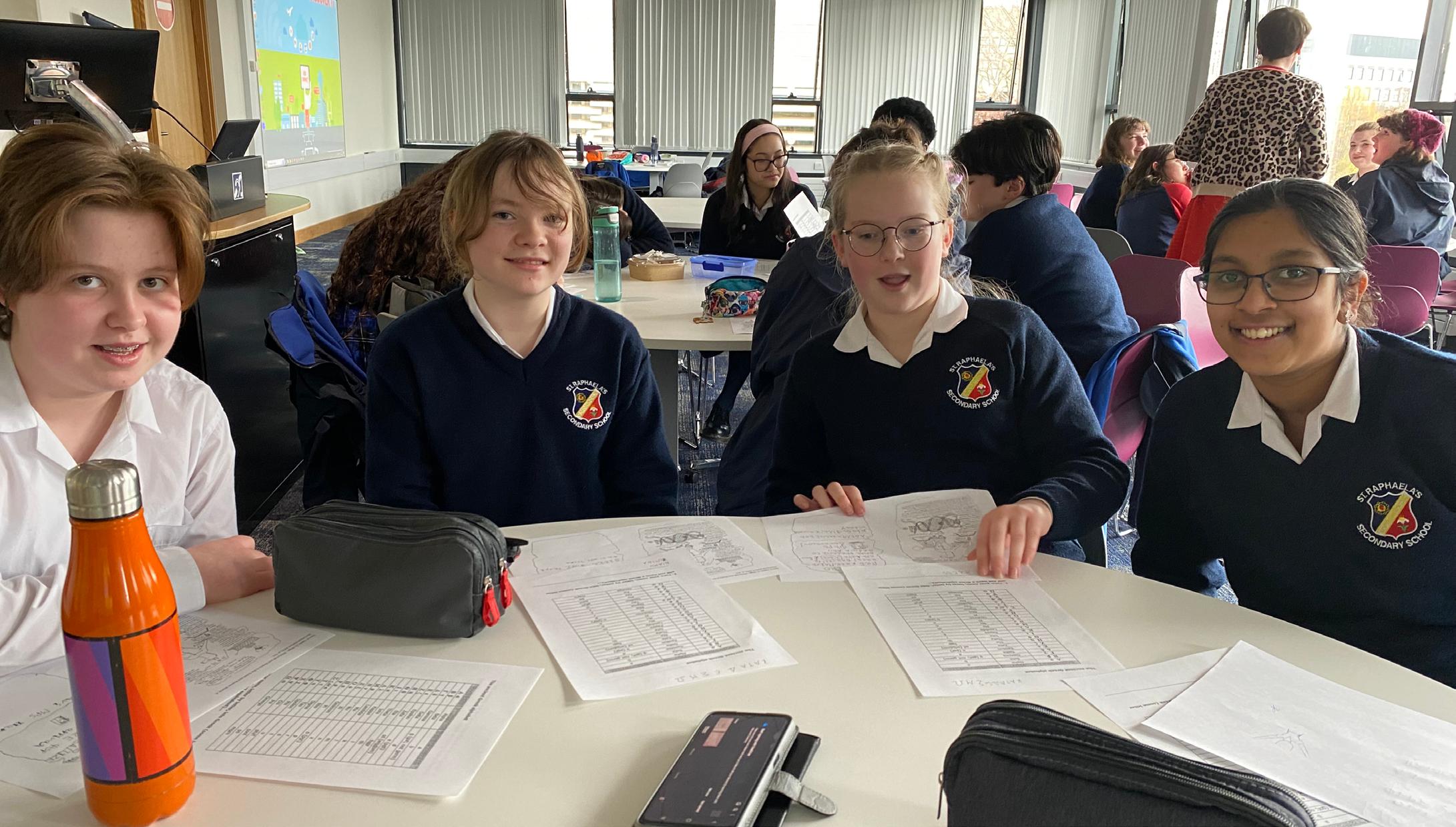
6 JUNE 2023
Students from St Raphaela's learning about ancient Greek and curse tablets during their UCD visit.
Photo (c) Dylan McKeever
handouts and PowerPoints from the day are available on the Access Classics website) to a full house of about 180 students and teachers!


Dr Martin Brady, Dr Christopher Farrell, and Dr Bridget Martin ran their level-three Access Classics module in UCD for the third time this year. This module, which teaches students techniques of outreach andengagement, tends to attract very dedicated and enthusiastic students, and this year was no exception! From conducting podcast interviews to producing posters explaining and advertising artefacts from the Classics museum, doing an amazing job with the module Twitter account (@AccessClassics), and being constant supports at Access Classics events, the students were a stellar bunch this year!
In exciting news, Access Classics will feature in an upcoming publication! Arising from a joint talk on Classics at second level in Ireland (for a Classical Influences and Irish Culture (CLIC) seminar in May 2022), Dr Arlene HolmesHenderson, Ms Aryn Penn, and Access Classics’ Dr Bridget Martin wrote a chapter entitled 'Green shoots on the Emerald Isle: an update on Classics in schools and communities in Ireland' for Class and Classics, a Trends in Classics volume by De Gruyter. We are particularly pleased that the chapter will be available through Open Access, so keep an eye out! Finally, in April 2023, Access Classics launched a survey of Classics at second level in Ireland, sending a questionnaire to all secondlevel schools in order to gain a greater understanding of: the current landscape of Classics in second-level schools in Ireland (e.g. how many schools offer Classics in some form, how many students take Classics/Greek/Latin, how many schools offer Classics at TY level); why the majority of secondlevel schools cannot/do not offer Classics; and the impact of Access Classics, particularly the use of the Access Classics Transition Year Unit on Classical Studies. We look forward to seeing what emerges from the responses!
It was another hectic year, and fingers crossed next year will be too!
The Classical Association of Ireland
Notice of Annual General Meeting
The Secretary notifies members that the Annual General Meeting of the Association will take place at Maynooth University on 19 August 2023.
The Council at its meeting on 22 April 2023 made nominations under Article 12 as follows:
Chair: Joan Wright
Vice-Chair: Bridget Martin
Secretary: Patrick J. Ryan
Treasurer: Alexander Thein
Members by Election:
1. Helen McVeigh
2. Cosetta Cadau
3. Amber Taylor
4. Adam Conry
Branches may make further nominations not later than 5 August. All such nominations should be signed by the Branch Chair or Acting Chair and returned to me by post or email.
Article 14 Special Motions and proposals for amendment of the Association’s Constitution should also be notified to me by the same date.
Patrick J. Ryan, Secretary.
Contacts:
Post:
The Orchard Yard, Newport, Co. Tipperary.
E-mail: p.strepsiades@gmail.com
7 www.classicalassociation.ie CLASSICAL ASSOCIATION OF IRELAND
Photo (c) Caitríona Maher
Cumann Clasaiceach na hÉireann
Photo (c) Bridget Martin
DU Classical and DU Archaeological Societies: ARISTOPHANES' ASSEMBLYWOMEN


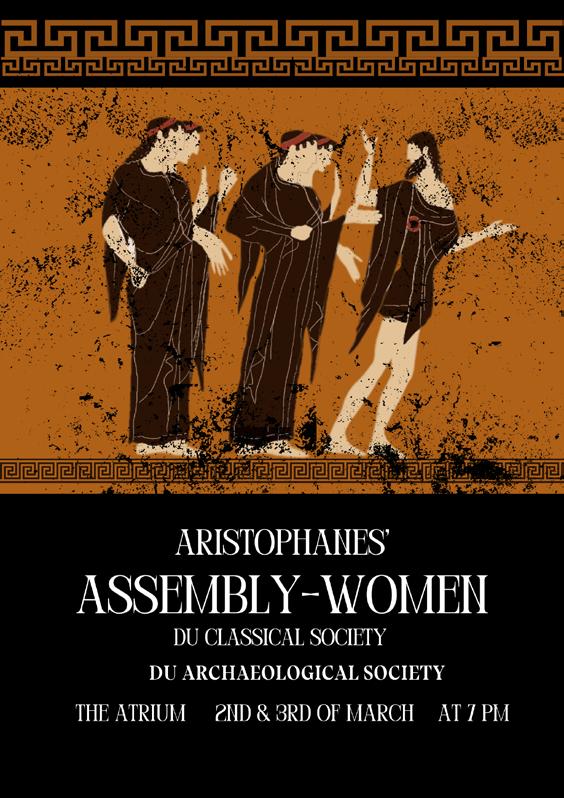
This year, we at the DU Classical and DU Archaeological societies put on Aristophanes’ Assemblywomen. The process started back in October 2022 with auditions, where we saw a host of people performing monologues from antiquity, Shakespeare, and even Ferris Bueller’s Day Off. After assembling our stellar cast, we started to work with weekly auditions, which were very difficult to organise as our actors came from many walks of the college life, consisting of classicists, other arts students, and a few scientists as well; additionally, there were a variety of ages, all undergraduate years and postgraduates too. Everything was co-ordinated fantastically by our producer Dora Foster. After a lot of hard work, which intensified when we came back from the winter break in Semester 2, came the performance dates. You’d have thought the struggles that came with auditions and rehearsals would be relieved by now, but half way through putting up the set in the performance space, we were advised that workers would be coming in half way through our show to remove chairs to place in the next room, an extra stress for our actors, so we then had to delay the performance time by an hour and beg campus security to let us run over closing time by 15 minutes. But they did, so: success! The set was minimal and overall the show was rather Brechtian, in that the costumes and props were stylistic and relatively minimalist, with everyone wearing a toga, the ‘columns’ in the back being sheets of paper with printed column heads on, a cardboard door with drawn on detail, and a Doctor Who DVD. There were frequent moments of 4th wall breaking, a rap battle, slapstick physical comedy, and poo jokes. I think Aristophanes would be proud. The two performances went by mostly without a glitch (but our wonderfully talented cast managed to use their more than competent improvisational skills to amend any deviations, adding extra comedy on top of the already very funny performance) and both nights were incredibly well received and enjoyed by all. The performances were recorded and will be uploaded to our YouTube page TCDClassical soon.
Crew: Written by Aristophanes; Directed by Gabriel Youngs; Produced by Dora Foster; Props and Costumes made by Henry Hubbard and Gabriel Youngs; Items sourced by Adam Roe and Gabriel Youngs
Cast: Ari Gorman as Praxagora; Elisa Zito as Woman A; Giorgia Carli as Woman B; Declan O'Donnell as Blepyros; Blau Farré as Neighbour; Leonardo Zimbalatti as Chremes; Anastasia Motiti as Chorus Leader & Herald; Alánagh Keane as Girl; Nathan Young as Youth; Zoë Bointon as Hag A; Daisy Connor as Hag B; Caitlin Leach as Hag C; Niamh Hamlpin as Servant; Adam Roe, Caitlin Leach, Henry Hubbard and Oisín O'Reilly as Chorus Gabriel Youngs
8 JUNE 2023
Poster by Alánagh Keane; Photos (c) Andrew McSweeney
Classical Association in Northern Ireland

In recent months, CANI’s annual School’s conference took place in the Ulster Museum. Despite the snow, we had 100+ pupils in attendance across the primary and post-primary sections. We had 3D printed ancient Roman board games and mask making galore. Post-primary pupils were treated to talks of Constantine and the Roman Republic. Everyone involved had a brilliant day and we are already planning for next year.

In March 2023, we had the brilliant Dr Arlene Holmes-Henderson speak for us on ‘Perspectives of Classics Education in the 21st Century’. This talk was hosted online and was very well attended by people across the globe. Such a fascinating and insightful talk – we were delighted to learn of all the brilliant things happening in Classics at the moment.
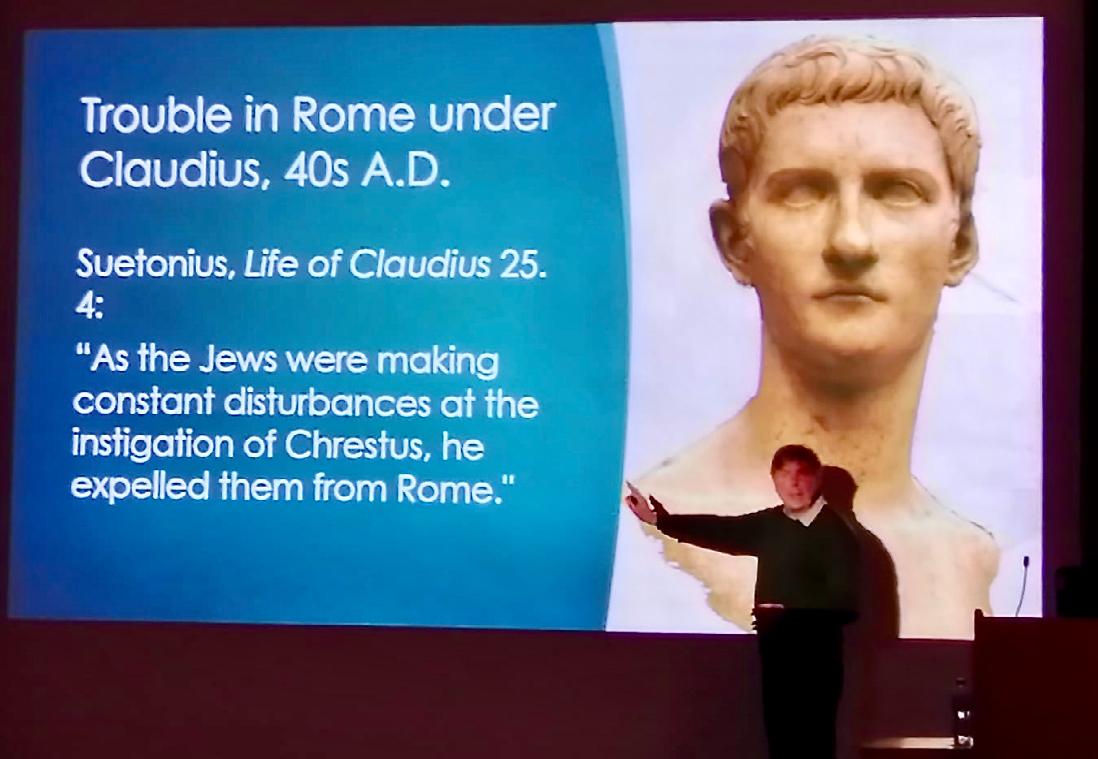
Looking ahead on the CANI calendar, we have our movie night in June (stay tuned for more updates!). Our final event of the year will be hosted in Navan Fort, a new venue for us. Dr Rena Maguire will be speaking on ‘Late Iron Age Ireland, Rome and Equitation’. Certainly not one to be missed!
As always, we also look forward to Helen McVeigh’s Classics Academy Summer School in July/August 2023. See helenmcveigh.co.uk for more details.

9 www.classicalassociation.ie CLASSICAL ASSOCIATION OF IRELAND
Amber Taylor
CAI Branch & University News
CORK
February 2023: Our new year got off to a great start with a talk from Dr Crystal Addey of the Classics Department in UCC. Indeed, the spring programme was a hat-trick from the Classics department with David Woods and Catherine Ware speaking in March and April respectively.

Dr Addey’s talk centred around ‘Female philosophers in the Platonic Tradition’. Three women were mentioned in the course of the talk: Diotima of Mantinea (who many think is a fictional character even though she is in Plato’s Symposium), Aspasia of Miletus, and the poet Sappho. There are few surviving writings by women and those which do exist suffer issues of authenticity and lack of context. Most evidence about women was written by men, which then tended to be slanted to the male perspective. Another factor for the lack of female writing was their access to education, or absence thereof. In Plato’s time, aristocratic women were not educated, though Aspasia of Miletus was an exception. Clea of Delphi, a philosopher, priestess, and colleague of Plutarch features as a character in Plutarch’s On Isis and Osiris and Virtues in Women. In spite of all these restrictions, women were members of almost every philosophical school/movement in Greek and Roman antiquity, albeit in a minority.
March 2023: Dr David Woods, also from the Classics Department in UCC, spoke to us about ‘Constantine the Great and the Pagan Origin of the Chi-Rho symbol’. From 306 until 337 it was a symbol of the Roman Empire; today, most people know it as a symbol for the Catholic church. According to Eusebius of Caesarea, Constantine saw this-cross shaped light in the sky around 312 AD. (Modern scholars explain this as a solar halo.) As a result, Constantine designed a new flag, a labarum. Eusebius is careful to emphasise that Constantine was victorious in his battles under this new flag!
By 312 AD and thanks to the Battle of Milvian Bridge, this sign of the cross was a Christian symbol. It began to appear in many places, such as milestones in North Africa and on coins. As with any interpretation, questions and controversy abound. In 310 AD, the God Sol appeared on Constantine’s coins and remained until 319 AD. From 319 AD, a star appears on his coins. Was it the polar star, or did the star represent the sun, or the radiant cross in the sky? One could assume that Christians saw the cross and pagans saw the sun! By 380 AD the cross image on coins finally triumphed.
April 2023: This month it was the turn of Dr Catherine Ware, also of UCC, to talk to us about ‘When I grow up, I want to be Medea’. Medea is a rather conflicting figure. This woman betrayed her father, King Aeetes of Colchis, to help Jason steal the Golden Fleece and then later on he betrayed her. In revenge, she murdered her children and Jason’s new wife. Medea appears in every genre of literature but once she appears in a story, she takes over! Medea was seen as a barbarian from Colchis and therefore evil was something which would come easy to her.
In literature, Medea was seen as the ‘helpermaiden’. Jason is a literary celebrity, but his character is undermined because he needs help from Medea to finish his quest. Indeed, Medea is often modelled on Nausicaa, who was deemed the first helper-maiden in Homer’s Odyssey Dido is also strongly modelled on Medea. She is almost a folktale character. Jason is a cheating sailor, Medea is a witch, he fades, she grows. We found out that there was a lot more to this woman. She deserves for us to be better acquainted with her!
May 2023: Members’ Papers. Our final night of the year saw us welcome two speakers during our members’ paper section. The first speaker of the night was long-term Branch member and supporter Seamas Kirkpatrick, who gave a very interesting paper on ‘Free Time in Antiquity’. The basic question was: how did the ancients have fun? The answer may surprise you! They enjoyed their free time very much, like we enjoy ours. The evidence was, of course, garnered from the upper classes as the lower echelons in society, true to form, did not have that much spare time. Seamas stressed that despite the intervening thousands of years, human nature was not all that different between the classes. Plato maintained that wrestling was a manifestation of philosophy, while chariot racing and gladiatorial games were hugely popular.
There were in the region of one hundred and twenty festivals in Athens each year, so there was always something to keep its citizens occupied. We saw some wonderful slides on the extreme sport of bull-jumping at Knossos, and knucklebones and tabula, the precursor of backgammon. If all else failed, there were always bars to go to and drown your sorrows. Bars, it seemed, were not fussy who entered: male and female could enter together and while these were usually the domain of the lower classes, the upper classes mixed religion, politics, and cleanliness as part of their leisure activities. How little our lives have changed in one way!!
10 JUNE 2023
Photos (c) Joan Wright
Our second speaker was Master’s student Romana Semler and the topic for discussion here was the late antiquity poet 'Optation' (Publilius Optatianus Porfyrius), of the fourth century in the time of Constantine. His early and close relationship with the emperor soured and Optation was exiled. It was in exile that he became famous as a poet. His offerings were meant to reingratiate himself with Constantine. These were highly technical poems, written as grid poems, thirty-five lines by thirty-five letters. Such complexity puts Shakespeare’s sonnets to shame, and the code makers and breakers of the Second World War too. Basically, these were poems written within a poem. Imagine a star shape or a cross shape. Each word can be read as part of the text grid or as part of the whole poem itself. We learned that Optation wrote in the region of thirty such poems. One can only marvel at his ingenuity and perseverance in the face of such a task!
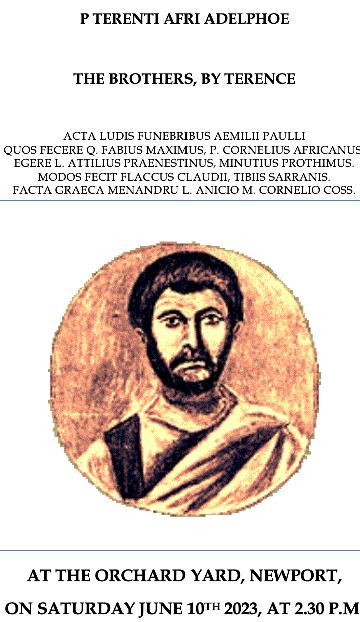
Thank you to all who supported the Branch during the year. We look forward to your company in the autumn.
Jennifer O'Donoghue
LIMERICK
The committee thought it wise not to ask members to attend meetings until Spring had made its appearance. By then, a programme of four lectures had been devised. We continue to rely on the good offices of the Limerick Education Centre, in Dooradoyle, to accommodate us for our functions.
On 8 February, our own Patrick Ryan led off with 'Selene: the Moon in Ancient Greece', Part 1. Patrick followed with Part 2 on 22 February. These were outstanding lectures, which showed the depth of Patrick’s research and the effort he put into choosing the many brilliant illustrations. I would highly recommend either, or both, to other Branches.
Sadly, we had to postpone Dr Maeve O’Brien’s lecture until later in the year. Instead, our final lecture on 5 April, 'Isca Dumnoniorum: the rise and fall of Roman Exeter', was given by Dr Edward Moxon-Browne, Dept. of Politics, U.L. Dr Moxon-Browne gave an excellent talk, with copious maps and illustrations as back-up. We were honoured to have Dr Edward Walsh, an ex-Honorary President of the Association, among the attendees.
Apart from attending lectures, members also participated in online reading sessions in both Greek and Latin. These were led by Daniel O’Connor, on Sophocles’ Oedipus Rex, Lisa Doyle, on Herodotus' The Histories, and Damhlaic MagShamhráin, on Horace's Epistolae. Some brave members even tracked through Thucydides III, under Dr Andrew Smith!
The unveiling of a plaque on 22 March by the Bulgarian Ambassador to Ireland in honour of James D. Bourchier, at his original home in Bruff, Co. Limerick, attracted great interest. Bourchier, a TCD Classics graduate, settled in Bulgaria and became a national hero there in the late 19th and 20th century. The Limerick Branch, which hosted a lecture on his life in 2021, was represented at the unveiling ceremony by our chairperson, Paula Keane.
An article that appeared in The Irish Times on 4 April might gladden, or sadden one. It pictured Abbot emeritus Christopher Dillon OSB of Glenstal Abbey as “one of the country’s last Latin teachers”. Abbot Christopher, who is an associate of the Limerick Branch, made a brave defence of the value of Latin in the article. He gave an interview in the same vein later, on RTE radio.
Finally, our academic year will end with a soirée on Saturday afternoon, 10 June, hosted by Patrick Ryan, in his beautiful rural haunt, The Orchard Yard (left). This is situated just off the R503, on the Limerick side of Newport. After a welcoming cup of tea around 2.30, and after Patrick has hoisted the flag of Greece to our applause, we’ll relax under the chestnut trees and hold a reading of Terence’s Brothers (English translation). What better way to celebrate Summer!
Tom Seaver (Branch Hon. Secretary)
11 www.classicalassociation.ie CLASSICAL
OF IRELAND
ASSOCIATION
DUBLIN
The Dublin Branch started its spring programme of events with a lecture on 28 February by Dr Eric Kondratieff from Western Kentucky University to share his research on coinage and Roman roads in Italy: ‘From Rimini to Rome: Recovering and Experiencing Augustus’ Monumental Program on the Via Flaminia’. Dr Kondratieff gave us a virtual tour of the Via Flaminia, the main road north from Rome to the Ariminum on the Adriatic, highlighting the bridges, arches, and the Augustan coin evidence for monumental sculpture in urban settings or on arches spanning viaducts: equestrian statues with trophies, four-horse chariots with Victory and naval rostra, as well as chariots drawn by two elephants. Analysis of numismatic antecedents indicate that the road monuments allude to Augustus’ military victories over Antony at Mutina in 43, over Sextus Pompey in Sicily in 36, over Antony and Cleopatra at Actium in 31, and over the Parthians in 20 B.C. Particular attention was paid to the well-preserved town of Carsulae. Our speaker joined us from Bowling Green, Kentucky, and our audience was spread from the United States to the UK and Ireland, and all the way to Jerusalem.

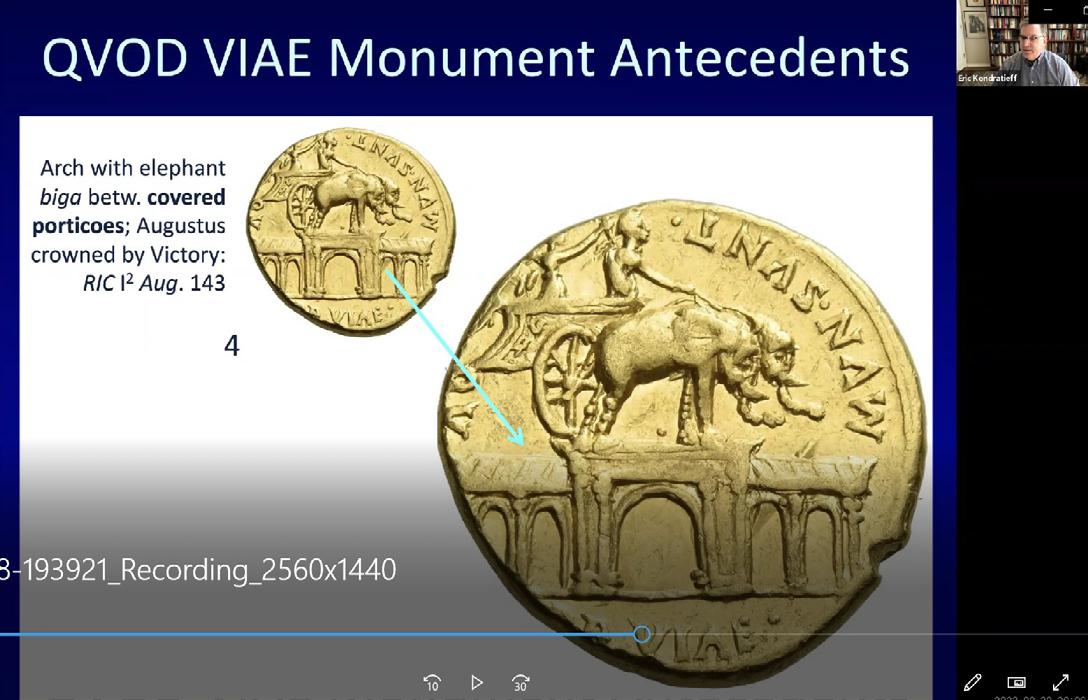
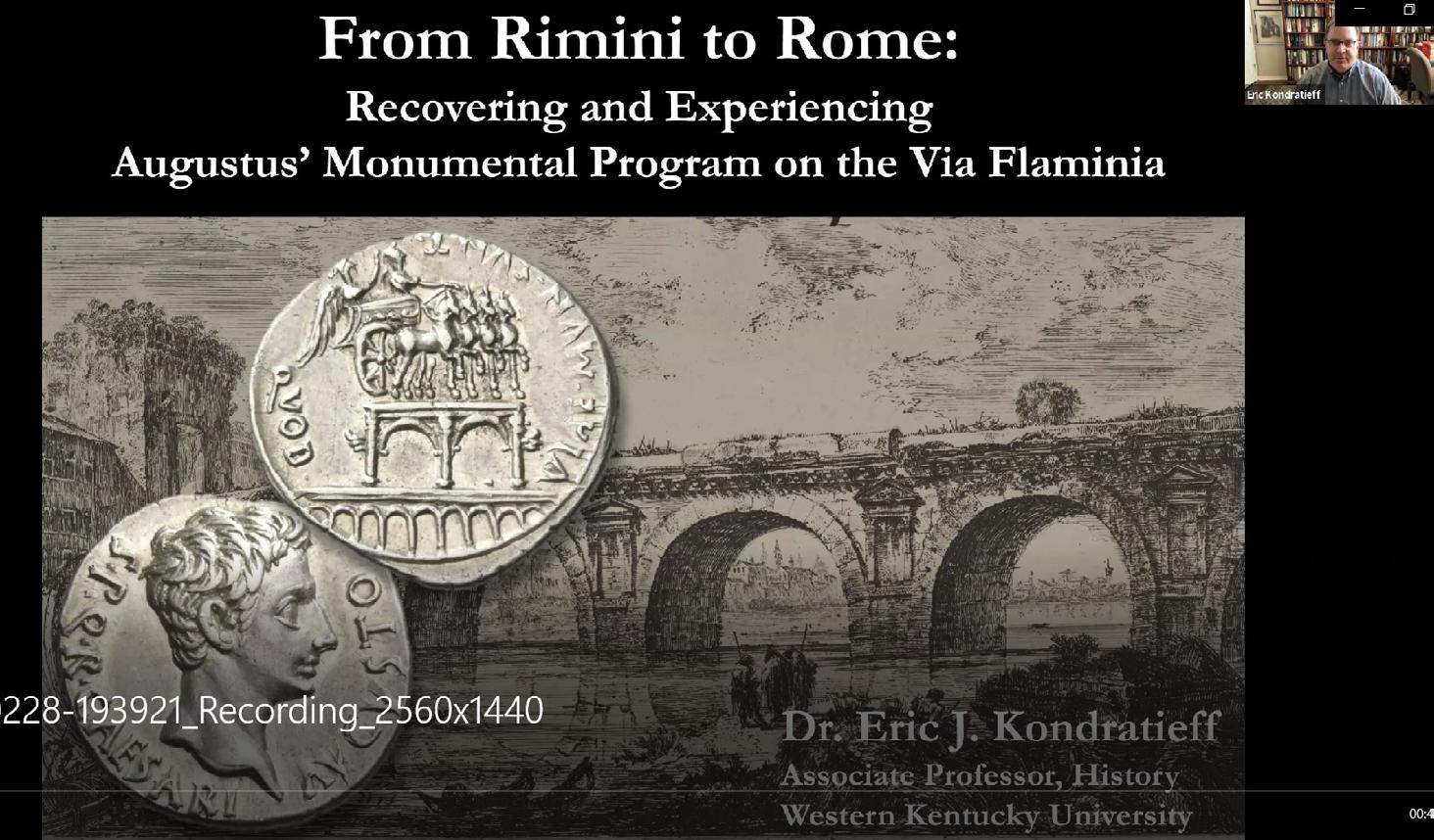
On 16 May we welcomed Dr Rosie Wyles, who delivered a talk on ‘Tragic Props and Athenian Civic Identity’. Dr Wyles explored how props can be intermediaries between the world of theatre and society, and took us through a variety of examples from the tragedies of Aeschylus, Sophocles, and the comic play Lysistrata by Aristophanes. The lecture highlighted the importance of voting urns and swords for expressing civic ideals on the stage and how these objects can take on different meanings in their life outside the theatre, which results in them being reframed by playwrights like Aristophanes. Over forty attendees joined us from across Ireland and the UK, and as far away as Perth, San Francisco, and Mexico. For anyone who missed it, this talk will be available to watch on the Classical Association of Ireland Youtube channel.
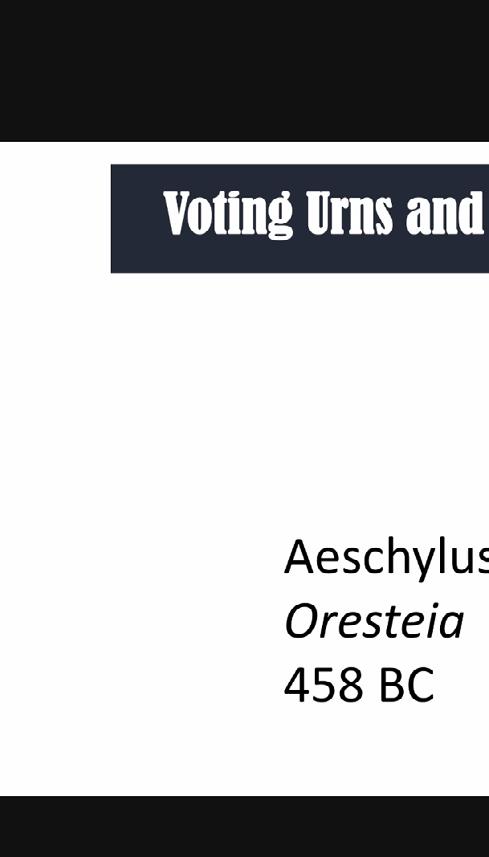
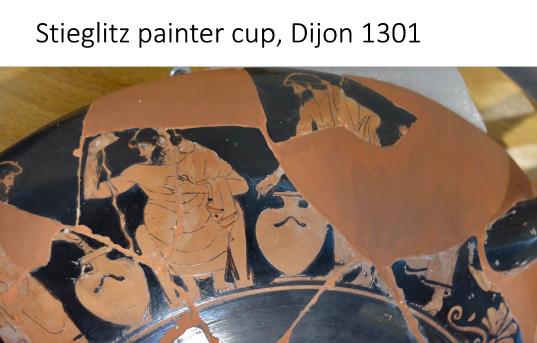
12 JUNE 2023
Dublin Branch Ramble in Monkstown
This photo might make you think that you were looking at a building and greenery in some country far further south than Ireland. But no, here we see the marvellous C. of I. Parish Church of Monkstown, Dún Laoghaire - Rathdown. And the “palm tree” is the Cordyline Australis or Cabbage Palm, sometimes known as the Irish Palm tree, although it is neither a palm nor a tree (nor indeed a cabbage!).
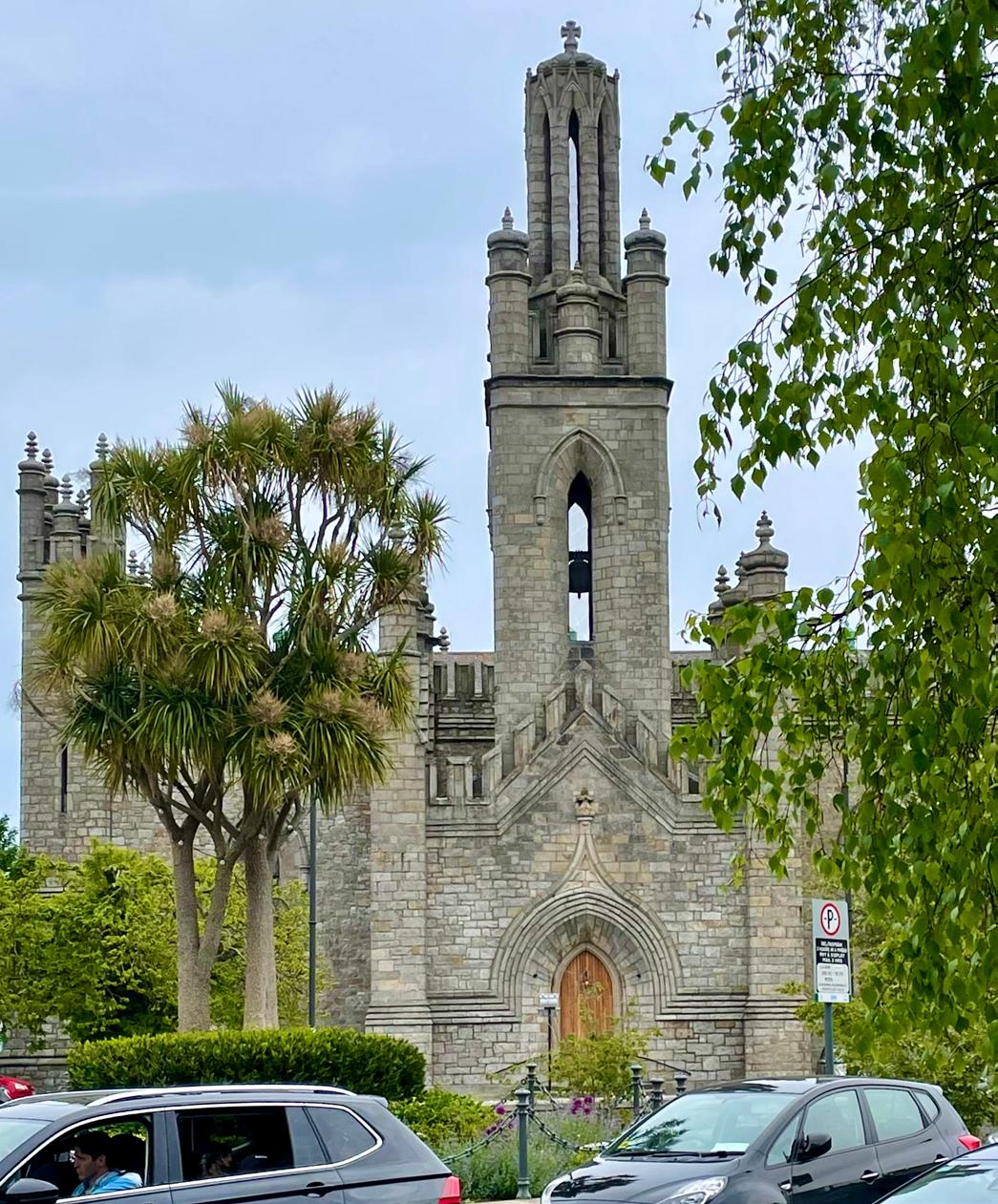
Saturday afternoon, 20 May, we met up outside the Parish Church, eight members of the Dublin Branch, and were greeted by Séamus Ó Canainn, our guide. Full of information and wise insights and droll facts, Séamus conducted us on a very entertaining and informative 90-minute walking tour of the heart of Monkstown. Again and again Séamus drew our attention to extraordinary details in the buildings which we passed: the shamrocks that decorate the ridge of the roof of the Catholic Church of St. Patrick, recalling the story of St. Patrick explaining the idea of the Triune Christian God to the pagan Gaels, or beautiful ironwork that decorates many garden walls and gates from the 19th century, even the detail that all the addresses on Monkstown Cres. have numbers that end in A: the Avoca Food Market is 11A Monkstown Crescent. Why? Because in the old days all those buildings were stables for the fine houses of Longford Terrace and each keeps the connection in mind by mirroring the house number of its former owner, adding the ‘A’ to differentiate it.
In the doorway to the pharmacy in the heart of the village, Seamus drew away the floormat at the entrance to reveal the word SALVE in mosaic stone. An appropriate wish for customers of a pharmacy! Over the years, the ‘V’ of the word came to be worn down far more than other letters, a sign, as Seamus pointed out, of the way people stepped into the shop with right foot first.

We have enjoyed a wide variety of events this term, from our Branch talks to the Greek and Latin Reading Circles and, of course, the Presidential lecture. On 17 May we had our first hybrid meeting of the Latin Reading Group, hosted in the UCD Village, and on 20 May we had a Saturday afternoon walking tour of Victorian Monkstown led by expert local guide Seamus Cannon, author of Monkstown: A Victorian Village.
We look forward to rounding off the term with our final talk from Dr Hannah Platts (‘Beyond Taste: Multisensory Experiences of Dining in the Roman Domestic Realm’) on 6 June.

13 www.classicalassociation.ie
OF IRELAND
CLASSICAL ASSOCIATION
Lisa Doyle and Alexander Thein
Photos (c) Liam Bairéad
JUNE 2023
The C. of I. Parish Church designed by the Semples, father and son, and open for worship since Christmas Day 1831, was one of the largest churches of its time and could accommodate 1,300. The Society of Friends is also present in Monkstown: passing their premises, Séamus pointed out to us a small plaque on the wall commemorating the famine relief that the Quakers of Monkstown organised for the starving, one of their many works of charity. Monkstown’s rôle as a fashionable place of residence in the 19th Century is attested by the fine rows of houses along Grosvenor Terrace and especially Pakenham Terrace, whose residents once had uninterrupted views of the sea.
So often, Seamus reminded us of the need to pause and observe, as when at the junction of Grosvenor Terrace and Packenham Road he asked us to pause and listen carefully. And as we did, we heard rushing water, the sound coming through a manhole in the middle of the junction. Beneath, two of the many streams that still flow under the surface in the area conjoin, then rush on down to meet the sea close by.
We heard how Monkstown got its name, Baile na Manach, the Town of the Monks, from the Cistercian monks of St Mary’s Abbey in Dublin: the land where now Monkstown stands was granted to them in the 12th century and remained theirs till the Orders were suppressed during the Reformation in the 16th Century. The names of the families into whose ownership the land subsequently came are remembered in many public places and roads around: Longford Terrace and Packenham Road, Vesey Public Park, and de Vesci Gardens.

This was a lovely way to spend a Saturday afternoon, deepening our knowledge and appreciation of the history and beauty of one of Dublin’s nicest suburbs. Let’s hope that we make more opportunities for ourselves to meet up over the summer!

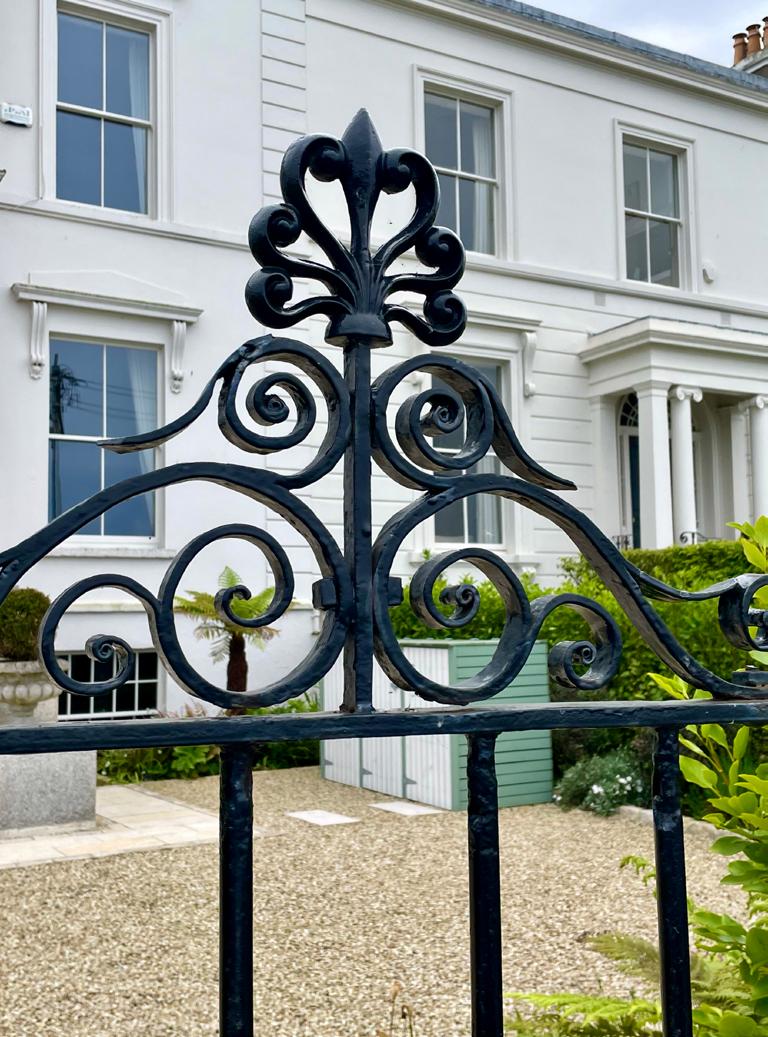 Liam Bairéad
Liam Bairéad
14
TRINITY COLLEGE DUBLIN
At TCD we continue to foster our vibrant teaching and research culture. Our Wednesday afternoon Research Seminars continued throughout the semester in a hybrid form, attracting a great number of national and international participants.

We welcomed two new Postdoctoral Fellows this year: Dr Alexandra Madela, working on an IRC-funded project on the Argonautica by Orpheus; and Dr Francesco Ripanti with a two-year Marie Skłodowska-Curie award for the ‘Linking Community Archaeology and Wellbeing in the Mediterranean’ (LOGGIA) project.
TCD Classics has long-standing and much valued links with Cyprus. In January we were delighted to participate in a new collaboration, involving a formal Memorandum of Understanding between Trinity College Dublin and the University of Cyprus; this was signed on a recent TCD Global visit to Cyprus where, in collaboration with the Irish Embassy and local schools, Dr Giorgos Papantoniou gave talks about our teaching programmes and our existing collaborations. In this context, following an Award by the Ministry of Education, Culture, Youth and Sports of the Republic of Cyprus for the project ‘Fostering Cypriot and Greek Studies in Ireland’, we were able to announce a bursary in Cypriot or Greek Archaeology for a student registered on the MPhil in Classics.
In February we were happy to co-host an event, called 'It's all Greek to me', in collaboration with the Greek Embassy in Ireland to mark International Greek Language Day. The Greek Ambassador Ms Magdalini Nicolaou opened the event, and we were also pleased to welcome the Cypriot Ambassador, Ms Charis Christidoulidou. Our panel of speakers comprised postgraduate researchers Lisa Doyle and Alastair Daly, our modern Greek teacher Valentina Papandrouladaki, and TCD Classics alumnus, Paddy Sammon, while Dr Charlie Kerrigan acted as respondent. Each speaker chose one word from either ancient or modern Greek to present, offering a fascinating insight into the richness and changing uses of language. We hope to establish this as an annual event!
In March, Prof. Carl Knappett (University of Toronto) delivered the 2023 W. B. Stanford Memorial Lecture series, over three days, on the topic of ‘Exploring change in protohistoric societies: futurity in the ancient Aegean’. Following the pandemic, it was a great pleasure to welcome colleagues, students, and alumni in person to this special event for our community.

In April we welcomed Prof. Maria Cecilia D'Ercole (L'École des hautes études en sciences sociales – Paris) as a Visiting Fellow, in the context of an agreement of exchange and collaboration between TCD and her institution. In addition, for a second year, colleagues in TCD Classics gathered for a one-day workshop on 'Approaching the
Hellenistic World' which showcased research on Hellenistic literature, history and archaeology by our staff, postgraduate researchers and postdoctoral fellows. Last, but not least, we were fortunate enough to be able to advertise a new position in Latin, and we are delighted to welcome a new colleague in Dr Charlie Kerrigan, who will be joining us in August as an Assistant Professor in Latin.
15 www.classicalassociation.ie CLASSICAL ASSOCIATION OF IRELAND
Above Postdoctoral Fellow Dr Francesco Ripanti introducing his LOGGIA project at a TCD Classics seminar. Below Prof. Carl Knappett with Kate Webb, granddaughter of W.B. Stanford, at the 2023 Stanford Memorial Lecture series.
Giorgos Papantoniou
Photo (c) Giulia Osti
Photo (c) Anna Chahoud
UNIVERSITY OF GALWAY
On 10 February 2023 we were delighted to welcome Lisa Doyle, a PhD candidate at TCD, to give a talk to our Centre for Antique, Medieval and Pre-modern Studies (CAMPS) on knowledge and learning in ancient Greek scholia. We hosted a day of Odyssey-themed talks in the Galway City Museum on 18 February, when Dr Pádraic Moran gave a workshop for children titled ‘Who was Odysseus anyway?’ (right). Their knowledge of the Odyssey was most impressive! In the afternoon Dr Moran gave a talk for an audience of more mature vintage, on the story of teaching Classics through Irish at University College, Galway (as we were then). It focused on the well-known figure of George Thomson (Seoirse Mac Tomáis), who taught Greek through Irish from 1931 to 1934, as well as Margaret Heavey (Mairéad Ní hÉimhigh), who taught Classics through Irish during her long career from 1931 until 1979, and who is still remembered fondly by many former students. We live in hope that Thomson’s lost translation of the Odyssey, no doubt influenced by the idiom of the Blaskets where he spent his summers, will eventually reappear. The event also featured readings of the Odyssey in Irish, English and the Greek original by Laoighseach Ní Choistealbha, Mary Madec, and Chiara Corongiu.

In memory of Prof. Heavey, we were delighted to revive her annual named lecture after a pandemic hiatus. This year, on 23 March, Dr Eoghan Maloney from Maynooth came to speak on ‘Old new kings: Alexander the great and the presentation of power’. It was a rich and very lively lecture, which generated much discussion during the questions afterwards.
Among staff research presentations, Prof. Michael Clarke gave a lecture to the Swedish Collegium for Advanced Study in Uppsala on 27 April, comparing the presentation of poetry in Byzantine and medieval Irish manuscripts. The event was jointly organised by the departments of Greek and Celtic Studies. Dr Edward Herring gave a talk to the Accordia Research Institute in London on 23 May on south Italian red-figure pottery. His latest book, Patterns in the Production of Paestan Red-Figure Pottery, was published in paperback this year.
We have a very engaged undergraduate cohort this year, and thank you very much to Dr Jo Day for welcoming no less than 17 of our students to the UCD Classical Museum on 3 April (right). Congratulations also to our PhD students who successfully defended their theses: to Harry Tanner for his work on ancient Greek lexical semantics and to Noémi Farkas for her study of the Hiberno-Latin manual on governance De rectoribus Christianis, written in the ninth century by Sedulius Scottus.
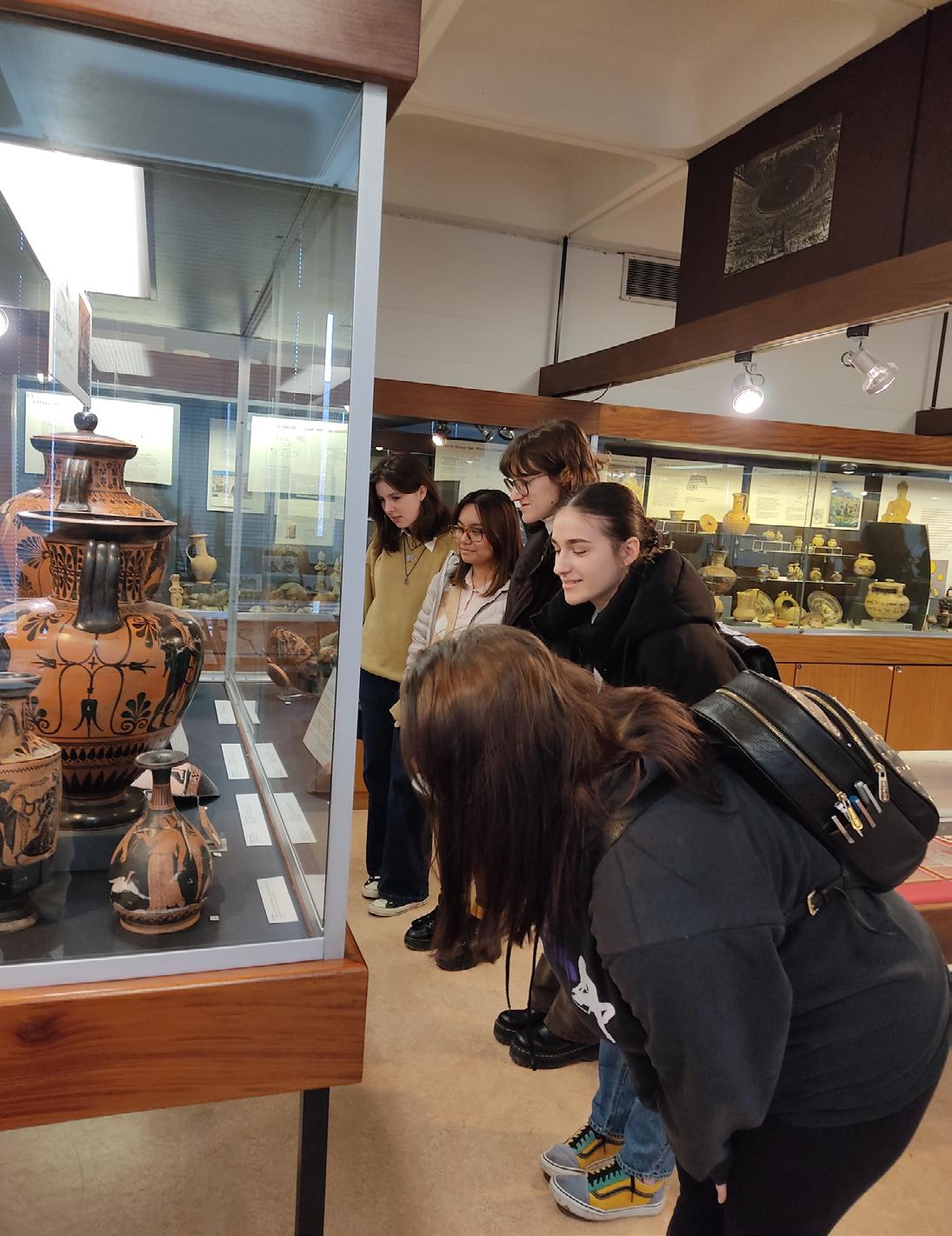
You can read more about the activities of the department here: https://www.universityofgalway.ie/classics
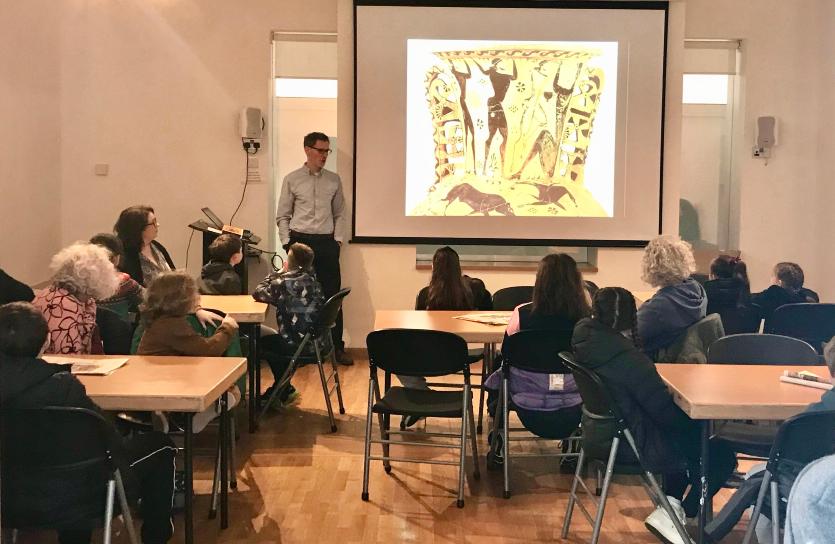
16 JUNE 2023
Pádraic Moran
Photo (c) Jo Day
MAYNOOTH UNIVERSITY
Dear All, greetings from Maynooth! The beautiful May weather puts us in mind of sunny dog days of August! Maynooth University is delighted to host the CAI Summer School, 18-19 August 2023. This is the first ‘in person’ Summer School gathering in several years. I am so looking forward to seeing you all here. The Dublin Branch worked hard at organising a very exciting programme of events, now finalised for your enjoyment. Talks will take us over the globe and far away! Some of what is on offer follows.
Jane Masséglia, our keynote speaker on Friday night, will talk on 'Hoodies with knives: a field guide to the Romans of Inner Anatolia'. This paper introduces a community of lesser-known Roman citizens living in the challenging conditions of rural inland Turkey. We will examine their appearance, family structures, and daily habits - all information which has been preserved through a remarkable cache of archaeological and textual evidence. It is a celebration of the variety of communities within the Roman Empire, and the rewards of looking at Roman life outside the locations taught traditionally.
Jane will return on Saturday morning to discuss the large Trojan War mosaic at the Rutland Roman villa in the East Midlands that was discovered during a Covid lockdown walk in 2020 and excavated by the University of Leicester in 2021. It is one of the most significant mosaics ever found in Roman Britain and gives us new insights into the ‘high’ culture of the Roman north-west. Created by highly-skilled mosaicists, it shows three scenes from the tale of Hector and Achilles, and Jane will argue that it illustrates a lost play of Aeschylus. There will also be a discussion of illustrated manuscripts with an Irish connection. I cannot wait!
Athens will be the scene for my colleagues Eoghan Maloney and Kerry Phelan, and our former colleague Jon Davies will return with Josephus and more banditry to round off our proceedings.
One very special event will be a lecture by Andrew Smith on Saturday the 19th in memory of our dear Brian O’ Connell (R.I.P.) entitled 'Visions, miracles and the pursuit of happiness'. Andrew advises that his lecture concerns the ways, from the very beginning, Greek thinkers adverted to differences between philosophical truth and traditional religious experience. This developed into a more sophisticated debate in the third/fourth centuries AD when philosophers began to pose more profound questions about how the Gods could influence human affairs, and just how ritual actions and prayers could influence the Gods. This trend of religious Platonism may be noted particularly in Asia Minor and Syria. But some philosophers avoided and counselled against such developments. Others attacked them as hoaxes. Is there a case to be made for genuine religious experience? That should transport us to a higher plane!
You are all assured of a massive Maynooth welcome. Further information is in our programme overleaf.
Maeve O'Brien
CAI Summer School 2023
Save the Date and Registration Details
The Dublin Branch is pleased to announce the programme for this year’s in-person Summer School at St Patrick’s College, Maynooth University. The keynote speaker is Dr Jane Masséglia, University of Leicester, who will give two lectures: the first on the social history and daily life of a Roman community in rural Anatolia, the second on the Trojan War mosaic excavated by the University of Leicester at the Rutland Roman villa in 2020/21. We are also pleased to announce the inaugural Brian O’Connell Memorial Lecture, which will be delivered by Prof. Andrew Smith on Saturday morning. The full programme of lectures is listed overleaf.
The dates-to-save for the Summer School are Friday 18 August and Saturday 19 August. There is no Sunday outing, but there is an optional walking tour of the Old Campus of St Patrick’s College on the Friday evening before the keynote lecture. Registration includes coffee/tea breaks and a light lunch on Saturday. This and the optional conference dinner on Saturday will be served in Pugin Hall.
• Full registration: €70, students: €30
• Saturday day rate: €40, students: €20
• Saturday night dinner in Pugin Hall: €35
• Tour of St Patrick's College Campus: €5
Cheques/POs payable to ‘CAI, Dublin Branch’ should be sent to CAI Dublin Branch Treasurer, Liam Bairéad, 3 Garrán Pháirc na Gráinsí, Rath Eanaigh, Dublin 5. E-mail: liamclasaiceach@gmail.com
For electronic payment options by Paypal or Stripe, e-mail the CAI Treasurer: alexander.thein@ucd.ie Payment should be accompanied by your name and contact details (address, phone, e-mail). Receipts will be issued by e-mail if an address is supplied, otherwise by post.
To assist with planning, we would appreciate registration and remittance by 31 July 2023. If you wish to book an ensuite heritage room on the Maynooth campus, please use the website www.maynoothcampus.com. Use the voucher code CAI_03/23 for the reduced conference rate. It is available until 22 June 2023.
17 www.classicalassociation.ie CLASSICAL ASSOCIATION OF IRELAND

18 JUNE 2023
































 Liam Bairéad
Liam Bairéad





